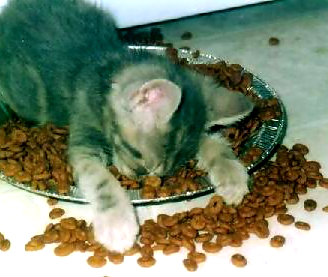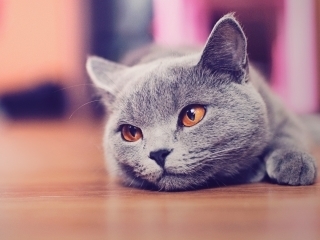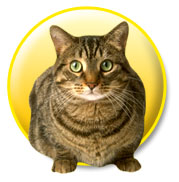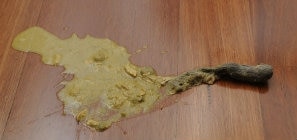Worst Case Cats: Free Choice Kibble
Simple Two-Step To Success

So much kibble, so little appetite
Oh oh. Do you do this?
The food dish is never empty, you just keep adding food as your cat finishes it.
When you switch to moist food, this won’t be possible, and you’ll be on your way to a Vital Cat. But till then, please read this and take these simple two steps now, if you feed dry food by filling up the bowl whenever it’s empty.
In a nutshell, you’ll do your cat a huge favor by:
1. Feeding only at intervals.
2. Putting “leftovers” away for another try later.
I know. It’s easier to fill the bowl when it’s empty, and let Samantha eat whenever she wants. But this habit leads to some serious health problems:
- Obesity
- Liver Disease
- Finicky Appetite
- Poor Digestion, including hairball vomiting
- Bladder Crystals
Remember, you have a predator in your midst when you have a cat in your care. You can easily see that the word “domestic” applies very loosely to the feline! We humans have, at the most, selected for appearance in breeding the modern domestic cat. We have not changed much else, because we’ve not worked to do so by applying genetic selection.
So, think about how a predator eats in the wild. Take the big cats as a good example. The lion or tiger or bobcat gets hungry, seeks prey, works to get the prey by hunting and killing it, and then feasts.
Afterwards, it’s time to lie in the bush, tend to grooming, keep the cubs in line, and generally forget about food. Until the hunger returns. That may be two or three days later, and the cycle begins again:
Hunt. Kill. Gorge. Rest.
Contrast this to your “wild” cat who’s become a pet. The prey is in the bowl already, so there’s no work involved in getting it other than ambling over (strrretch!) to the kitchen.
If the food stays out, most cats will get into the habit of never really getting hungry enough to gorge. They’ll act hungry, but eat little. Maybe a mouthful or two, and it’s on to other projects. Over time, that creates problems.
“No, I’m not pregnant or nursing, I’m not even female!”
One big one is obesity. Just as in people, if snacking fills the day, the weight can increase past a healthy set point. And part of this is that digestion is interfered with.
The analogy is one of cooking rice. Imagine starting the process of cooking rice (here, the rice is the food in the “digestive fire” of the stomach). If, part way into the cooking of the rice, you lift the lid and add more rice, you end up with a mess at the end. Some is cooked, some is not.
A similar mistuning takes place in snacking cats. They have not really finished the digestion of the prior meal and taken the needed break before hunger returns. The food dish is full, there’s not much else going on to interest them, and so they return to the kitchen for another mouthful. This can happen several times in the day and night, and before you know it, this cat has a fat belly pad.
And obesity shortens life and sets the cat up for other health problems, including diabetes and liver disease.
“No, I think I’d like something else to eat. Not that, either.”
The same mistuning of digestion is responsible for the problem that can drive you crazy: finicky appetite. Unless the brand or type of food is changed pretty regularly, Puff won’t eat. And do we get worried about that!
“Well, if you don’t like the liver and bits, maybe you’ll eat the seafood feast? No? OK, wait, I’ll get your old favorite, shrimp-flavored chicken fillet.”
Still not much eaten. Why? There’s no hunger, for one thing! The boredom factor sets in. No thrill of the hunt, no wind in the face with the pursuit of the prey, no working with the rest of the pride, just a comfy bed near the fireplace, so who cares? Eating becomes a habit, and interest wanes over time as food is always available.
“Ewww! What did I just step on, Harry?”
I suspect hairball vomiting is also related to the poor digestion that comes from snacking. Normally, swallowed hair moves with the rest of the digestive contents through the intestines and becomes part of the stool. When it accumulates in the stomach due to poor digestive function, it sets up discomfort and eventually needs to be vomited out.
If you see hairballs more than once every few months, you are seeing the evidence of a digestive problem. When was the last time you saw a lion in the zoo with a hairball? Ask the keepers — I’ll bet they never see one!
“OUCH! Hey, I’ll be right back, I gotta run for the litter box.”
Another problem with free choice feeding is bladder crystals. A cat normally has concentrated and acidic urine. Anytime eating takes place, there’s a brief change to alkalinity, as the bicarbonate pours into the small intestine as part of digestion. This is normal, and happens in all species.
But when your cat becomes a snacker, he becomes more like a cow, and stays alkaline most of the time. This results in urine alkalinity, which means the crystals come out of solution (compounded if the food is dry, as mentioned above).
In your male cat, this can result in a plug forming in the urethra, the narrow passage that brings urine from the bladder through the penis and out. These plugs, made of crystals and often mucus, can actually prevent the escape of urine entirely.
This makes your male cat not only very uncomfortable, but downright sick, as he fills up with the toxic waste material that should have gone out into the grass or the litter pan.
These poor boys usually end up in the emergency room repeatedly until the diet is (artificially) acidified or they get a surgical operation that cuts the penis open (ouch!). And these repeated bladder problems seem to set him up for kidney failure later in life.
The takeaway from this, that’ll keep your boy out of the ER?
Feed raw, balanced food.
You can thank me later.
The HOW of Limit Feeding
So, how you mimic the wild cat’s eating habits becomes the basis for a healthier digestive system in your domestic feline companion. This, in turn supports his urinary system’s functioning as nature intended.
Overall vitality is enhanced and longevity added to his life by doing just a couple of simple things in feeding your cat.
The First Step is:
- Offer 30-minute meal times only once or twice a day.
 Remember that wild cat hiding out in your domestic cat’s body? Well, though he doesn’t have to hunt to get fed, we can mimic the inherently natural “gorge and fast” model through limiting his “windows of opportunity” for eating.
Remember that wild cat hiding out in your domestic cat’s body? Well, though he doesn’t have to hunt to get fed, we can mimic the inherently natural “gorge and fast” model through limiting his “windows of opportunity” for eating.
Cats in nature eat on a 28-hour cycle. Offering food at intervals once or at most twice a day simulates this. While you would not be happy eating so seldom, please keep in mind that cats and humans are different creatures entirely!
The Second Step: Take it Up!
- Next, pick up any food left after allowing a 30-minute feeding time.
That’s right. Pick it up and put it away. Moist food can be saved in the refrigerator for a couple of meals. Before offering it again, warm it slightly by putting the dish in a bowl of warm water (your cat needs to smell what he eats, and cold food doesn’t appeal to him partly because it doesn’t smell like food).
Your Cat Thanks You
So, taking these couple of simple steps, you’ll have made a great leap forward on the way to Vital Cat Health! No more eating like a cow for Puff!
Next step: Back Away from the Kibble, Kitty (how to transition, in baby steps, from dry food to healthy food for cats).
Mroowww.



